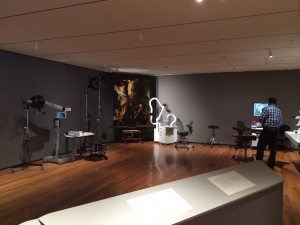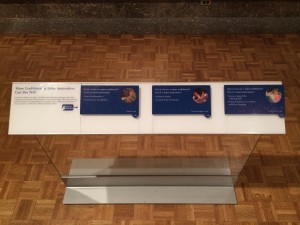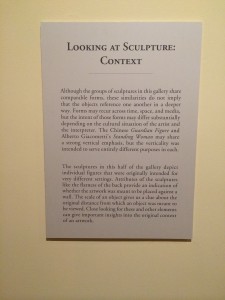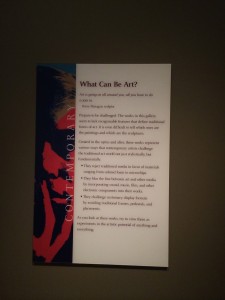Thus far this summer, I have been doing a great deal of reading on pedagogy and visual culture in conjunction with a number of related projects I am working on. In my research, I am widely seeking to understand the place and value of a “critical pedagogy” in different sites of aesthetic education, such as art history classrooms, museums, and other spaces dedicated to art.
In the midst of our image-saturated culture, many philosophers, media theorists, art historians, and education-specialists have heralded the importance of what some call a “visual literacy”: broadly, the ability to “read,” “scan,” or “decode” images, with a discerning and critical eye. While students of art history and visual culture have engaged these practices actively in their studies, the public rarely has exposure to some of the critical tools that many scholars feel are crucial in our individual and collective efforts to navigate challenges of politics, identity, and culture. Unlike languages, which are often standardized and region-specific, a ‘visual literacy’ can traverse geopolitical boundaries but does not operate with any codified grammar; rather, it is intended to foster a critical disposition towards images (their history, appearance, presentation, distribution, acquisition, etc…) in any setting.
With the help of my research, I am thinking about different strategies for teaching and supplying a larger public with this type of ‘literacy’ or education, in spaces outside of the academy. Currently, I am working on one project, with the support of a former director of a New York museum, that involves presenting an abridged education in different ‘techniques of seeing’ to museum-goers upon entering a collection of art. In addition to reading about various approaches to education in the museum, I took a road trip with a friend and visited a few museums that have garnered a reputation for doing highly innovative work with the didactic materials in their galleries.
Finally, I am also using my research to write two-related articles that critique different contemporary practices of capturing, sending, and reading images. I am in the process of editing one of the articles right now and I hope to write the second in August.
Here are some pictures from the museums I visited and a few accompanying considerations :

This is an experimental gallery currently installed at the Clevland Museum of Art. While nearly all museums confine the process of conservation to labs out of view, on or off-site, Clevland is actively conserving a significant work by Caravaggio, openly in a gallery. The accompanying didactic text (shown at the bottom portion of the picture) makes the experience a highly successful and informative one, as the museum’s crucial role as steward and conservator of historical objects is foregrounded.
Here is an example of some of the didactic material found in the Detroit Museum of Art. While these texts, which are situated in front of some works, might successfully engage the interest of the viewer with questions, I believe that it does not work well on a number of accounts. Most importantly, it is crucial that viewers are able to commune with art objects in personal ways, such that educational materials do not necessarily legislate the experience of viewing but rather support it in more discreet ways. Detroit’s labels are designed so that each question posed about an object can be physically lifted or moved to reveal an answer. This type of exercise is detrimental to fostering any form of critical thinking, as the artwork is transmuted into a puzzle and the difficulties of interpretation are reduced to a simplified question/answer format.
The picture on the left is a label from the Toledo Museum of Art in Ohio and the one on the right is another from Detroit. These, I believe, are much more successful in that they provide viewers with a general framework and language through which to approach objects, without dictating how a single artwork should or should not be viewed.




This is really interesting. However, to me, the idea that visual literacy as inoperable within a codified grammar is doesn’t seem quite so valid. Is it not inextricable from codification, from a system, if there is a claim to decode works of art that are inherently permutational, if not entirely personal? Curious as to what you think.
I am really happy that you are approaching visual literacy outside of the academy, Zach, and think that if you are to be successful, you must approach your pedagogy with the spirit that drew you to the last two wall texts pictured in your post. (You already seem on the right foot here, but I want to echo and reassure your instinct!) What was successful to me about those two wall texts is the laying bare of the institutional and curatorial process, but doing so in an open, non-prescriptive way. It seems to be encouraging a dialogue, rather than enforcing what they believe the art and its display to be doing. Really cool!
I suppose my questions, ones you have surely been mulling over, have to do with the language of the pedagogical efforts towards visual literacy, or what for me would be an anti-literacy–a visual literacy constantly overturning previous visual literacies. How do we retain the complex theories or art historical backgrounds that often go into curating an exhibition or creating a work of art without alienating a beginner to visual literacy? When I think about my own concerns around art theory’s language, I often wonder about condescension, and how so many of the theories I love, and would love to teach or write further on, sound condescending towards the presumably visually literate reader, let alone the beginner. But then, when I think about the art world at large, there is condescension and, frankly, elitist B.S. all over the place! How can we incorporate a self-awareness of and resistance to that condescension in pedagogical methods or efforts? Sorry for the rant, much of your project comes together with my concentration, so I’ll be excited to hear what you think, and where your project goes!
Gabrielle